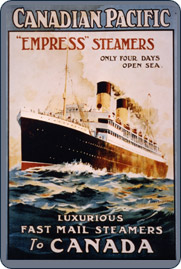Pointe-au Père, which is now a part of the City of Rimouski, has served as one of Canada's most important centres for aid to maritime navigation since the mid-1800s. Among other things, the community has served as a piloting station, a quarantine station, a Marconi telegraph station, and as the site of four successive lighthouses.
Today, the Pointe-au-Père Maritime Historic Site is one of the major historical attractions along this part of the Lower St. Lawrence coastline. There are three distinct components to the site. The first is the Pointe-au-Père Lighthouse. This lighthouse was constructed in 1909, and was the third lighthouse at this location (the fourth and final lighthouse, now also decommissioned, is visible nearby).
The third lighthouse, which is one of the earliest surviving lighthouses to be constructed of reinforced concrete, is one of the tallest in Canada. Its architecture, which features a system of projecting concrete buttresses, is unique.
Visitors can take a guided tour to the top of the lighthouse. The ascent involves 128 steps but the view from the top is breathtaking (although not, perhaps, for the faint of heart). Visitors will learn about foghorns, lighthouse prisms, and the life of the lighthouse keepers. The lighthouses at Pointe-au-Père have played a key role in navigation along this part of the St. Lawrence. The third lighthouse is classified as a National Historic Site of Canada.
 The second component of Pointe-au-Père Maritime Historic Site is the Empress of Ireland pavilion. R.M.S. Empress of Ireland was a luxury ocean liner owned by Canadian Pacific. The ship was struck by a coal freighter in heavy fog and sank in the St. Lawrence near Pointe-au-Père on May 28, 1914. The accident claimed the lives of 1,012 people. Only 465 passengers and crew survived, four of them children (the other 134 children on board perished). To this date, the event remains the worst peacetime maritime disaster in Canadian history.
The second component of Pointe-au-Père Maritime Historic Site is the Empress of Ireland pavilion. R.M.S. Empress of Ireland was a luxury ocean liner owned by Canadian Pacific. The ship was struck by a coal freighter in heavy fog and sank in the St. Lawrence near Pointe-au-Père on May 28, 1914. The accident claimed the lives of 1,012 people. Only 465 passengers and crew survived, four of them children (the other 134 children on board perished). To this date, the event remains the worst peacetime maritime disaster in Canadian history.
The Empress of Ireland pavilion features a 3D show about the shipwreck, interactive terminals, artifacts reclaimed from the wreck site by scuba divers, early photographs, and models of the great ocean liners of the twentieth century.
The third and final component of Pointe-au-Père Maritime Historic Site is also its newest attraction. Since 2009, the conventionally-powered submarine H.M.C.S. Onondaga, which served the Canadian Navy from 1967 to 2000, has been in permanent drydock at the site.
Over the course of its long career, the 90-metre submarine and its crew of 70 helped to patrol the Canadian coastline and participated in many NATO missions.
Now, the Onondaga is open to the public for self-guided tours (visitors are equipped with hand-held audio devices). It is the only submarine in Canada that is open to the public, and visitors will find a trip through this piece of recent maritime history a memorable one.